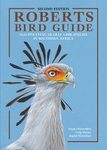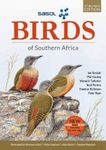By
Gehan de Silva Wijeyeratne
27 Dec 2022
Written for Paperback
My first visit to East Africa was in the late 1990s. I used a copy of
A Field Guide to the Birds of East Africa by John Williams (published by Collins). At that time, I thought it was excellent and I still have my copy of that book. On later visits to Kenya, I used the
Birds of Kenya and Northern Tanzania by Dave Zimmerman
et al. in the Helm Field Guides. This was a further improvement. On my most recent visit to Kenya, I used the Second Edition of
Birds of East Africa: Kenya, Tanzania, Uganda, Rwanda, Burundi by Terry Stevenson and John Fanshawe which is also published in the Helm Field Guide Series. The second edition published in 2020 is a significant update to the first edition published in 2002. The second edition covers 1,448 species in 289 colour plates compared to 1,338 species on 287 plates in the first edition. 17 Species of vagrants are covered in three pages (606-604) in the end sections.
My overall impression is that this is a fantastic field guide with both the text and illustrations to a very high standard. On a ten-day trip covering Nairobi, Amboseli, Tsavo West and Tsavo East National Parks there were hardly any birds which evaded ID. A few Little Brown Jobs evaded ID but this was no fault of the book. Any failed IDs were usually because I did not get sufficiently good views and also because I am not familiar with the calls of difficult groups such as the Cisticolas. The illustrations by John Gale and Brian Small are first-class. They are both accurate in enabling ID and also pleasingly life-like. Not all field guide illustrations in books manage to be both accurate for field identification and also manage to be aesthetically pleasing. The concise, crisp text hits the target in enabling ID. The text is identification oriented as expected but also contains information on ‘Status and Habitat’ and ‘Voice’. The latter is especially important for some species. The text is remarkably good at conveying a good portrait of the bird in terms of identification, habits and distribution. Packing so much information into a small word count is a skill in itself. This is no doubt facilitated by authors who are expert birders who have spent many hours in the field.
The bulk of the book which are the species accounts (pages 22 – 598) follows the modern field guide format with the illustrations (right-hand side) facing the text and colour-coded distribution maps on the left. My only niggle is that I would have liked the political boundaries of the countries much more clear on the maps to help me orient myself to where I was in relation to the marked distributions. As the maps are small there is no space for locations to be marked on them to help orientate. The book broadly follows a modern phylogenetic taxonomy with a few departures to facilitate field use. The most obvious being that the Falcons (Family Falconiformes) are placed next to Hawks, vultures, buzzards and eagles (Family Accipitridae) rather than next to Parrots to show their true evolutionary relationship. Other birds in groups where the taxonomy has only recently been resolved (for example those with the words ‘warbler’ in them) may still have a traditional arrangement to help with field use. The plates are generally arranged to bring a taxonomic level together, whether this is at the level of family, sub-family, tribe or genus. Most plates have one or more headings explaining the taxonomic level. This was a feature I particularly liked. With families that are species-rich, it helps to have them broken down into smaller related groups with taxonomic notes that include pointers to help separate them in the field from other family members. It also helps to make sense of the various different taxonomic treatments in other books that precede this book. Occasionally as with the plate on the White Crowned Shrike and Helmet Shrikes, species which belong to two different families are placed together with an explanatory note that as in the past, they have been placed together to help with field ID. On the whole, a really good balance has been struck in educating the user of modern taxonomy whilst at the same time making the book easy for field use. The plates show distinct subspecies, and differences in sexes and immatures. Of course with groups such as birds of prey and gulls although a range of plumages is shown it cannot be a substitute for a more advanced family monograph.
For anyone using this book on a visit to a single country in the book’s scope, it can at times feel like there is too much as a country-level book could lose up to a third or more of the 1,448 species covered in the book. On the other hand, it is good to see the distribution of closely related species in the East African region across multiple countries. A country like Kenya is so climatically diverse that even within the country there are huge differences in the avifauna even within its own political boundaries.
The introductory sections contain a map with key place names, with brief chapters on Landscapes, Seasonality, Sites and Species (pages 10-15). Two pages cover bird topography. The chapter on ‘Additional Reading’ references key works, but a standard listing of references is not provided. This may be to avoid an already big book getting any bigger and is not a problem as an internet search will easily bring up the titles that have been referenced within the introductory material. The end sections include a list of the birds endemic to East Africa and maps of the important bird areas for each of the countries covered. There is a comprehensive index of common and Latin names with the very last page (page 640) having a quick index in alphabetical order to the bird groups. This complements the three detailed content pages at the front of the book where the birds are grouped by family in what largely reflects a modern phylogenetic relationship (with exceptions as mentioned earlier).
As someone who has authored field guides to birds and mammals, I suppose I have a deeper appreciation of the amount of fieldwork and desk work a book like this entails. Every time I thumb through this book, I am in awe of the amount of work that must have gone into producing such a superb field guide.












































